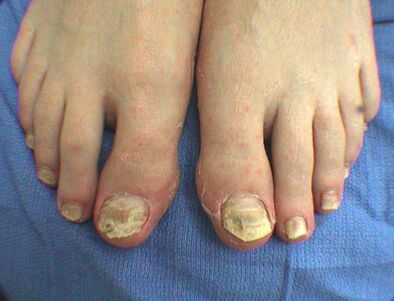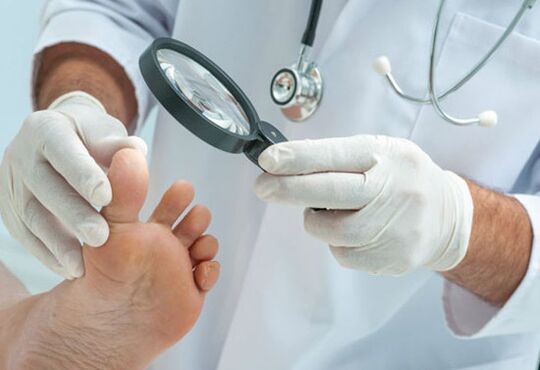Nail fungus (onychomycosis) is the most common disease in which the nails become yellow, become brittle and thick and are covered with cracks.The symptoms of nail fungus are hardly noticeable in the initial phases.Treatment of the disease is difficult due to impaired cellular immunity.The disease runs slowly, without the right treatment and can accompany the patient throughout his life.

Nail fungus is more common in a man and people with weakened immunity.Patients with diabetes, obesity, with blood vessel pathology and skin diseases are subject to diseases.With high sweating legs there is more chances of mushroom damage to the skin and nails on the legs.
The mushroom can climb clothes, shoes, manicure, carpets and floor onto the nail plates.It occurs through the skin of the skin and through the nail bed in the nails.It is a lot where it is warm and moist: in souls, bathrooms, changing rooms and pools.In healthy people, the disease rarely develops.
The cause of the disease
Onychomycosis is caused by three types of mushrooms (individually or in combination).Most cases of the disease are caused by mushrooms of the trichophyton -rubrum type.Much less often - trichophyton interdigital, epidermophyton floccosum and microsporum and aspergillus.
- The yeast mushrooms of the type of Candida Albicans always parasitate on skin and nails.The use of antibiotics, contraceptives and a decrease in immunity can develop yeast infections.
- Molds often cause diseases in countries with a tropical climate.
- Floor fungi live in the ground and only cause onichomycosis in some people.From person to person are not transferred.
Which is the source of infection
- Diseases in family and friends can become a source of pathogens for you.
The mushroom is transferred to the family by a joint towel, slippers, bedding, etc. - The fungus on the hands can become a source of the disease of the nails and skin of the legs.
- The fungus lives in a large number in bathrooms, shower and pools.
- The source of infection can be the patient's clothing and shoes, manicure, carpets and floors.
This increases the risk of the disease
- The mushroom of the skin of the feet.
- Reduce immunity.
- Family members who suffer from a mushroom.
- Older age.
- Diabetes.
- The presence of microtraumas and burrs.
- Increased sweating of the legs.
- Unknown and bad shoes.
- The habit of walking barefoot in public places.
- Accommodation and work in a wet climate.
- Long -term artificial nails.
This influences the development and progression of onychomycosis
- General health.
- Susceptibility to infections.
- The degree of moisture and thermal background.
- The type of nail plate (nails on the fingers slow down).

Symptoms of nail fungus
At the beginning of the disease, the usual color of the nail changes.It will be opaque.A gap in which the mushroom itself appears between him and his bed.
The nail is painted in one of the colors: whitish-gray, yellow, green and brown to black.Yellow elongated strips in the nail and below are visible.Spots of different colors.
The nail thickens and deforms over the affected area.Horn masses gradually grow and prevents medication from penetration.
First, an increased brittleness is determined, when the mushroom affects the entire nail plate, it begins to crumble and collapse.During the processing, a large amount of “garbage” from destroyed fragments and epidermis is formed.The skin is often damaged.
Forms of onychomycosis
- Distal U -Boat -onychomycosis.
- Lateral onychomycosis.
- White surface onychomycosis.
- Proximal tray onychomycosis.
- Total dystrophic onychomycosis.
Distal u -boat and lateral onychomycosis
This form of the disease is the most common.Up to 90% of cases are the cause of the mushrooms of the genus Trichophyton rubrum.The infection of the nail plate begins in the free edge of the affected skin of the foot.First, the nail bed is touched.The type of damage is similar to a splinter or a colored yellowish color.As the disease progresses, the nail thickens and can divide or separate from the skin.The distal U -boot -onychomycosis is difficult to treat.Wearing shoes causes discomfort.
White surface onychomycosis
The second most common form of onychomycosis.In 90% of cases, the disease is caused by the genus of the genus Trichophyton interdigital, which only affects the upper layer of the nail plate, which never thickens and does not separate from the skin.Over time, its entire surface becomes loose, like chalk powder.The healing occurs quickly.
Proximal tray onychomycosis
This form of onychomycosis is rare.The red trichophyte on blood and lymphatic paths spreads throughout the body.This is demonstrated by the damage to the nail from behind (proximal) and the detection of the pathogen in the lymph nodes of the groin area and the secretion of the prostate gland.The disease is often recorded in HIV -infected.The defeat begins with the skin in the area of the nail fold, which makes itself thicker.In addition, the nail plate is involved in the process, which receives a white impermeable color.
Total dystrophic onychomycosis
This form of the disease is a result of the progression of a series of types of the forms of onychomycosis mentioned above.The nail plate is partially or completely destroyed.
Diseases with similar symptoms

Of all infectious diseases, onychomycosis can be found in 50% of cases.Similar symptoms can be found in the following diseases:
- Eczema.
- Psoriasis.
- Reuters syndrome.
- Daria disease.
- Flat braid.
- Norwegian scabies.
Diagnosis of nail fungus
In order to obtain information about what causes certain changes, you must consult a dermatologist who organizes the diagnosis of the disease.The scratch of the part affected is sent to the laboratory to clarify the causes of the disease.
The microscopy identifies the presence of a mushroom, and the sowing of a nutrient medium underlines the pure culture of the pathogen and determines the sensitivity to antifungals.
Before the treatment begins, it is necessary to identify the type of infection. The mushroom of the nails on the legs is easier to warn.Examine feet and nails on your feet more often.Early treatment will help to quickly achieve improvements, to reduce the feeling of symptoms and to eliminate the cosmetic effect.



























